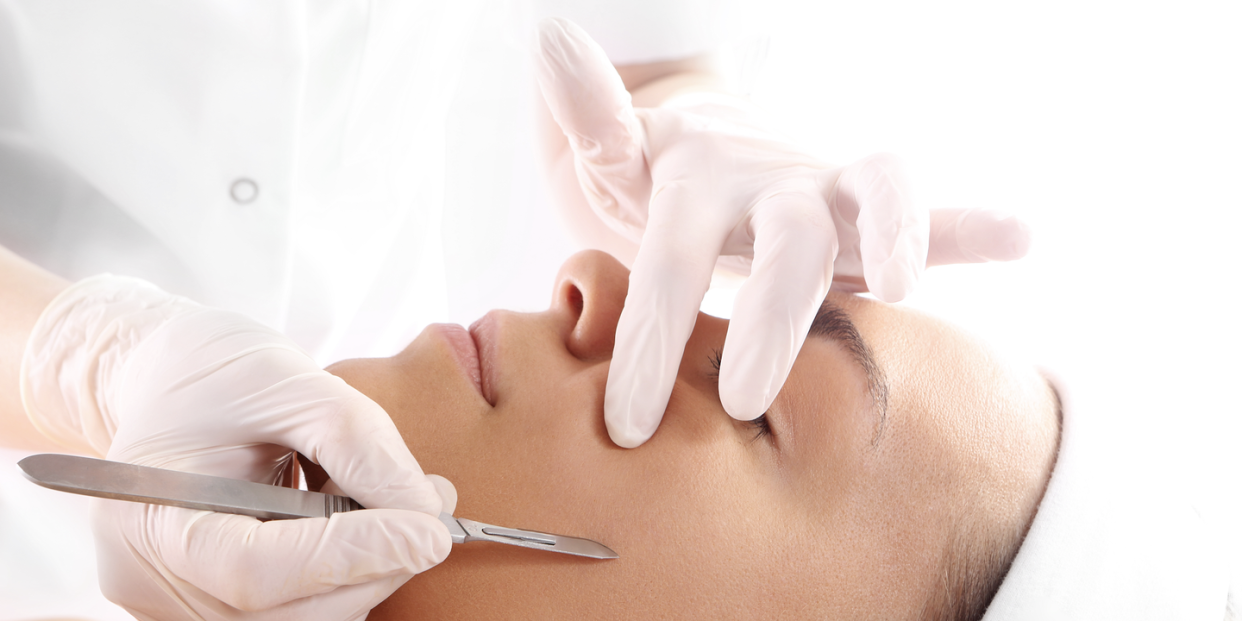Everything You Need to Know About Dermaplaning

If you’ve been anywhere near BeautyTok or Instagram Reels, you’ve likely seen beauty creators using tiny blades or scalpels all over their faces to shave off dead skin and peach fuzz. The practice is called dermaplaning, and it's meant to reveal the smoothest, glowiest skin of your life.
Dermaplaning can be done both at-home and with a pro, but whatever route you take, there are important safety precautions to know first (hello, razor blades). BAZAAR.com spoke with three board-certified dermatologists to get their take on the benefits, risks, and results of dermaplaning.
What is Dermaplaning?
Dermaplaning falls into the category of physical exfoliation, just like a scrub. This gentle form of exfoliation involves using a sharp blade like a scalpel or straight edge to shave off the top layer of skin on the face. The tiny but sharp blade removes layers of dead skin along with vellus hairs (peach fuzz). “Everyone has fine vellus hairs on their face, but some people's vellus hairs are thicker and more visible than others, so they may want to have these removed,” Hadley King, a New York City-based dermatologist, says. Fans of dermaplaning say removing this layer of hair helps their base makeup apply like a dream.
Is Dermaplaning Safe?
While the thought of running a sharp blade across your face might sound alarming (unless you already shave your face), dermaplaning is actually pretty safe when done correctly. Things can go left when “using blades or tools not specifically designed for dermaplaning or low-quality tools that don’t secure the blade can lead to potential injury to the patient,” Margarita Lolis, a board-certified dermatologist at Schweiger Dermatology Group in Hackensack, NJ, says. So, it's best to go to the pros while you become familiar with this treatment.
Although dermaplaning is safe, people with conditions like eczema, psoriasis, rosacea, or very sensitive skin might want proceed with caution. “Because you are removing the dead layer of skin cells which make up the stratum corneum, you are affecting the skin barrier,” Anthony Rossi Jr., a board-certified dermatologist, and founder of Dr. Rossi Derm MD, says.
How Often Should You Dermaplane?
Dermatologists recommend dermaplaning between once a week to once a month, but not more often than that. “If you disrupt the skin barrier too much and over-exfoliate, you may actually be making more inflammation," Rossi adds.
What Should You Consider Before Dermaplaning?
It's best to use gentle products prior to the treatment. Actives like salicylic, lactic, and glycolic acids, as well as benzoyl peroxide or retinoids before the treatment might make your skin more sensitive. You also shouldn’t go over any areas where skin is broken or irritated, nor should you swipe over any areas with active breakouts. Rossi also cautions against dermaplaning if you have a cold sore outbreak or an infection like staph impetigo.
How Should You Care for Your Skin After Dermaplaning?
Stay out of the sun and stay hydrated after dermaplaning. “It is also very important to avoid excessive heat, intense workouts, steam rooms ,and saunas for 48 to 72 hours after treatment to avoid the risk of hyperpigmentation,” Lolis says.
Rossi also recommends leveling up on the moisturizer: “A gentle emollient that is thick and acts as a sealant is a must.” He explains that this will ultimately help your skin trap water and improve hydration because “the very top layer [of skin] is now removed.” His go-to peptide serum from his skincare line calms sensitivity post treatment.
What Are the Benefits of Dermaplaning?
A brighter complexion and baby-smooth face aren't the only benefits. Dermaplaning actually helps to increase the penetration of active ingredients in your skincare products. “This means you could potentially see improvements in your skin faster with continued and consistent use,” Lolis says.
What Are the Risks of Dermaplaning?
It’s important to keep in mind that at the end of the day this is a method of exfoliation, so less is more. King points out that it’s important to support your skin barrier before and after exfoliating to help keep the risk of irritation as low as possible. “If you try to dermaplane dry or flaky skin, the risk of irritation and cuts will definitely be increased,” she says. And this is obvious, but make sure your tools are squeaky clean and disinfected before and after use. Replace your blades often, and don't keep them near your shower (where they could rust).
You Might Also Like

